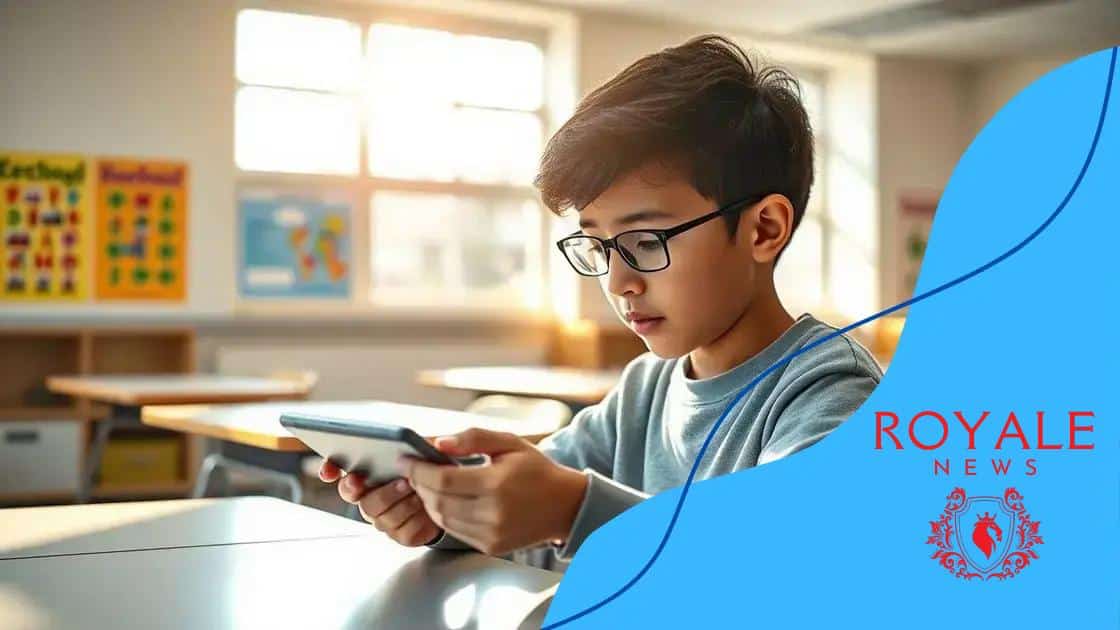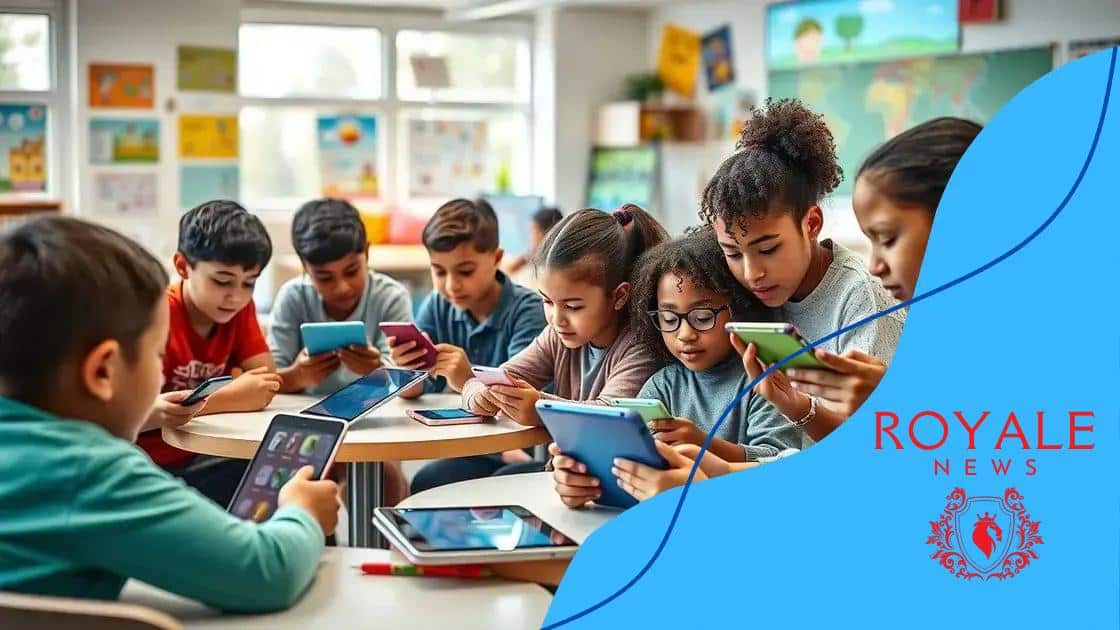Mobile learning apps enhancing education experience

Mobile learning apps enhance education by providing flexible, personalized learning experiences, improving student engagement, and supporting teachers with effective communication and resource management.
Mobile learning apps enhancing education are transforming how students learn. Have you ever wondered how these apps can fit into your daily routine, adding convenience and flexibility to your studies?
The rise of mobile learning apps
The rise of mobile learning apps has dramatically changed the way we access education. More people can now learn at their own pace and in their own space. This flexibility makes learning more enjoyable and accessible to everyone.
Key Features of Mobile Learning Apps
These apps offer various features that enhance the learning experience:
- Interactive content to engage users.
- Personalized learning paths based on user preferences.
- Offline access to materials, allowing for learning anywhere.
- Real-time feedback to help users track their progress.
As we explore the continued rise of these innovative tools, it’s important to understand their impact on both students and educators. Mobile learning apps provide a platform for innovation in traditional teaching methods. Educators can now integrate technology seamlessly into their curriculum.
Benefits for Students
Students gain many benefits from using mobile learning apps. For instance, they can adjust their study schedules according to their own needs. Also, learning can happen in various environments, whether at home, on the bus, or in a café. This convenience boosts engagement and retention of information.
Moreover, many apps employ gamification strategies. This approach makes learning feel more like a fun activity than a chore. As a result, students are more inclined to complete their tasks and stay motivated. The increased use of mobile devices among young people has accelerated the demand for education that meets them where they are.
Ultimately, the rise of mobile learning apps reshapes how and where learning occurs, promising a brighter future for education.
Benefits of mobile learning in education
The benefits of mobile learning in education are vast and transformative. With increased access to information, learners can explore subjects at their own pace. This flexibility enables them to fit learning into their busy schedules, whether they are on their commute or at home.
Accessibility and Convenience
One major advantage is the accessibility it provides. Students can learn from anywhere. This quality helps ensure that education is not limited by geography or time.
- Access to a variety of resources, including videos and articles.
- Ability to learn anytime, accommodating different learning styles.
- Instant access to quizzes and assignments for immediate feedback.
Additionally, mobile learning fosters personalized education. Apps can adapt to individual student needs, recommending resources that suit specific learning goals.
Engagement and Motivation
Mobile apps often use interactive elements, which keeps learners engaged. Features such as gamification make studying feel more like fun than a chore.
This increased engagement leads to higher motivation. Students are more likely to complete courses or modules when they find the content appealing and accessible. Furthermore, mobile learning can connect students with peers and instructors, fostering collaboration and communication.
Ultimately, the advantages of mobile learning in education are evident. Students benefit from flexible learning environments that cater to their unique needs, ensuring a more effective educational experience.
Top mobile learning apps for students

Choosing the right mobile learning apps can greatly enhance a student’s educational experience. Here are some of the top apps that students can use to improve their learning.
Khan Academy
Khan Academy provides a wide range of free courses in various subjects. The app allows students to learn at their own pace with instructional videos and practice exercises. It covers topics from math to science and even arts.
Duolingo
For those wanting to learn a new language, Duolingo is a fantastic choice. The app makes language learning fun through quick, interactive lessons that keep students engaged and motivated.
Quizlet
Quizlet allows students to create flashcards and study sets that can help reinforce their understanding of material. It’s effective for memorization and practice through games and quizzes.
Coursera
Coursera offers courses from top universities and organizations worldwide. Students can access lectures, readings, and assignments right from their mobile devices. It’s a great way to earn certificates in various subjects.
Google Classroom
Google Classroom helps students manage assignments and collaborate with classmates. This app is especially useful for keeping students organized and connected with their teachers.
These mobile learning apps not only facilitate better learning but also help students manage their time and resources effectively. With so many options available, there is an app for every learning style and need, making education more accessible than ever.
How mobile apps support teachers
Mobile apps play a crucial role in supporting teachers in their daily tasks. These apps streamline communication, enhance lesson planning, and provide valuable resources.
Streamlining Communication
One major benefit of mobile apps is the ease of communication between teachers, students, and parents. Apps like Remind and ClassDojo help keep everyone informed about assignments and events.
- Instant messaging for quick updates.
- Sharing important announcements in real-time.
- Receiving feedback from students and parents easily.
This continuous interaction fosters a supportive learning environment for students, making them feel more connected.
Enhancing Lesson Planning
Teachers can also use mobile apps to organize their lesson plans efficiently. Tools like Planbook and Google Classroom allow for seamless curriculum management.
Educators can create, share, and access lesson plans from anywhere, ensuring that they are always prepared. These apps can facilitate collaboration between teachers, enabling them to share resources and ideas.
Furthermore, many mobile apps provide interactive content that teachers can use directly in their lessons. Educators can incorporate videos, quizzes, and games that engage students and enhance learning.
Access to Educational Resources
Additionally, mobile apps give teachers access to a wealth of educational resources. Websites like Teachers Pay Teachers offer lesson materials created by other educators.
- Online courses to further develop teaching skills.
- Templates and worksheets for various subjects.
- Community forums for sharing best practices.
By leveraging these resources, teachers can improve their effectiveness and enrich their classrooms. Overall, mobile apps are making a significant impact on how teachers operate, leading to better educational outcomes for students.
Future trends in mobile learning technology
The future of mobile learning technology looks promising as innovations continue to emerge. With advancements in AI and connectivity, education is becoming more interactive and tailored to individual needs.
Personalized Learning Experiences
One key trend is the move toward personalized learning experiences. With data analytics, apps can assess a student’s strengths and weaknesses. This allows for customized lesson plans and resources suited to each learner’s pace.
- Adaptive learning technologies that respond to user performance.
- Content tailored to individual learning styles.
- Real-time feedback to enhance student engagement.
This personalized approach makes learning more effective and enjoyable, keeping students motivated.
Integration of Virtual and Augmented Reality
Another exciting trend is the integration of virtual reality (VR) and augmented reality (AR) into mobile learning. These technologies can create immersive learning environments that bring subjects to life.
For example, students can explore historical sites virtually or conduct science experiments in a simulated lab. This hands-on experience deepens understanding and retention of information.
Increased Collaboration through Social Learning
Mobile learning platforms are also shifting toward social learning. These apps enable collaboration among students, allowing them to share knowledge and learn from one another.
- Discussion forums and group projects facilitated through apps.
- Peer feedback on assignments and projects.
- Shared resources to enhance learning.
As social learning grows, students develop critical collaboration skills necessary for future careers.
Overall, the future trends in mobile learning technology signify a shift towards more engaging, effective, and inclusive educational experiences. With ongoing advancements, learners will have increasingly powerful tools at their fingertips.
In summary, mobile learning apps are reshaping education in remarkable ways. They enhance accessibility, promote personalized learning, and foster collaboration. With the future trends like virtual reality and social learning, students can enjoy more dynamic and engaging learning experiences. As we continue to embrace technology, it is clear that mobile learning will play a significant role in the evolution of education.
FAQ – Frequently Asked Questions about Mobile Learning Apps
What are mobile learning apps?
Mobile learning apps are applications designed for use on mobile devices to facilitate learning and education. They provide access to educational content anytime and anywhere.
How do mobile learning apps enhance student engagement?
These apps often use interactive elements, such as quizzes, videos, and gamification, that make learning fun and help keep students motivated.
Can mobile learning apps support teachers?
Yes, mobile learning apps assist teachers by streamlining communication, enhancing lesson planning, and providing access to educational resources, creating a collaborative environment.
What are some future trends in mobile learning technology?
Future trends include personalized learning experiences powered by AI, integration of VR and AR for immersive experiences, and increased collaboration through social learning features.





